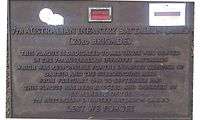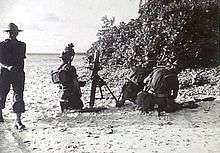23rd Brigade (Australia)
| 23rd Brigade | |
|---|---|
 A memorial plaque for the 23rd Brigade in Bicentennial Park, Darwin | |
| Active | 1940–1946 |
| Country |
|
| Branch | Australian Army |
| Type | Infantry |
| Size | ~3,500 men |
| Part of |
8th Division (1940–42) 12th Division (1942–43) 3rd Division (1943–46) |
| Engagements | |
| Commanders | |
| Notable commanders | Arnold Potts |
The 23rd Brigade was a brigade of the Australian Army. It was briefly raised in 1912 as a Militia formation providing training as part of the compulsory training scheme. Later, it was re-formed in July 1940 for service during the Second World War, the brigade was initially a formation of the Second Australian Imperial Force assigned to the 8th Division; however, after its sub units were captured by the Japanese in 1942 it was reformed with Militia battalions and was mainly used in a garrison role until late in the war when it was committed to the fighting on Bougainville. It was disbanded in 1946.
History
Early formation
The 23rd Brigade briefly existed as Militia brigade that was partially formed in 1912, following the introduction of the compulsory training scheme. At this time, it was assigned to the 6th Military District. The brigade's constituent units were spread across various locations in Tasmania including Lyell, Zeehan, Burnie, Devonport, Deloraine, Beaconsfield, Launceston, Scottsdale, Hobart and Huon. The brigade consisted of four infantry battalions, numbered consecutively as the 90th, 91st, 92nd and 93rd.[1] The formation was short lived, and was not raised as part of the First Australian Imperial Force (AIF) during the First World War. It remained on the order of battle as a Militia formation during the war,[2] but was not re-raised in the interwar years when the Militia was reorganised to replicate the numerical designations of the AIF in 1921.[3][4]
Second World War
The brigade was re-rormed in July 1940 at Seymour, Victoria,[5][6] for service during the Second World War, the 23rd Brigade was initially raised as a unit of the Second Australian Imperial Force, attached to the 8th Division. Upon formation it consisted of three infantry battalions—the 2/21st, 2/22nd and 2/40th Battalions—although later both a pioneer (the 2/3rd) and a machine gun battalion (the 2/4th) were added to its establishment.[7] These units were drawn from Victoria and Tasmania.[5] The brigade's first commander was Brigadier Edmund Lind.[8]
In August 1940, the brigade concentrated around Bonegilla.[5] When the 8th Division was sent to Malaya in early 1941, the 23rd Brigade remained in Australia. In March and April 1941, it deployed to Darwin until Japanese intentions became clearer. Nevertheless, ultimately its subunits experienced the same fate that befell the rest of the division. Broken up and sent piecemeal to reinforce the garrisons at Rabaul, Ambon and on Timor, the 2/21st, 2/22nd and 2/40th Battalions were all eventually destroyed or captured by the Japanese in early 1942.[9][10][11] Outnumbered and lacking sufficient air and artillery support, these units were quickly overwhelmed. While some members were able to evade capture and eventually rejoined Australian forces in New Guinea, most were captured. Many died in Japanese captivity. The 2/4th Machine Gun Battalion was also hastily deployed, reinforcing the 8th Division in Singapore where it too was eventually captured.[12]

While its constituent battalions were destroyed, the brigade's headquarters remained intact in Darwin, and consequently it was decided to reform the brigade with three Militia battalions—the 7th, 8th and 27th Battalions.[13] In March 1942, Brigadier Ivan Dougherty assumed command of the brigade.[8] Reassigned to the 12th Division,[14] the brigade was once again sent to garrison Darwin; however, in March 1943 it was relieved and sent to the Atherton Tablelands in Queensland to undertake training prior to deployment overseas.[15]
In 1944–1945, under the command of Brigadier Arnold Potts,[8] and reassigned to the 3rd Division,[14] the brigade took part in the Bougainville campaign. Initially they were used in a static role, garrisoning the Outer Islands, however, in 1945 the brigade was committed to the fighting on Bougainvile Island, where they took over responsibility for the central and northern sectors, engaging the Japanese in direct combat for the first time, carrying out patrolling operations and launchig a number of small attacks.[15][16][17] During one of these attacks, north of Ratsua, one of the 8th Battalion's members, Private Frank Partridge, performed the deeds that led to him being awarded the Victoria Cross.[17]
Following the end of hostilities, the brigade remained on Bougainville guarding Japanese prisoners as the demobilisation process began. Finally, in 1946 all its subordinate units were disbanded.[15][16][17]
Notes
- ↑ Australian Military Forces 1912, p. 28.
- ↑ Kuring 2004, p. 108.
- ↑ Palazzo 2001, pp. 68 & 91.
- ↑ Grey 2008, p. 125.
- 1 2 3 Mackenzie-Smith 2018, p. 2099.
- ↑ "23rd Brigade". Orders of Battle.com. Retrieved 14 February 2010.
- ↑ "23rd Brigade: Subordinate Units". Orders of Battle.com. Retrieved 14 February 2010.
- 1 2 3 "23rd Brigade: Appointments". Orders of Battle.com. Retrieved 14 January 2017.
- ↑ "2/21st Battalion". Australian War Memorial. Retrieved 14 February 2010.
- ↑ "2/22nd Battalion". Australian War Memorial. Retrieved 14 February 2010.
- ↑ "2/40th Battalion". Australian War Memorial. Retrieved 14 February 2010.
- ↑ Morgan 2013, pp. 12–14.
- ↑ "Second World War, 1939–1945 Units". Australian War Memorial. Archived from the original on 17 January 2010. Retrieved 14 February 2010.
- 1 2 "23rd Brigade: Superiors". Orders of Battle.com. Retrieved 14 February 2010.
- 1 2 3 "27th Battalion (South Australian Scottish Regiment)". Australian War Memorial. Retrieved 14 February 2010.
- 1 2 "7th Battalion (North West Murray Borderers)". Australian War Memorial. Retrieved 14 February 2010.
- 1 2 3 "8th Battalion (City of Ballarat Regiment)". Australian War Memorial. Retrieved 14 February 2010.
Bibliography
- Australian Military Forces (1912). The Military Forces List of the Commonwealth of Australia, 1 January 1912. Melbourne, Victoria: Government Printer. OCLC 221429471.
- Grey, Jeffrey (2008). A Military History of Australia (3rd ed.). Melbourne: Cambridge University Press. ISBN 978-0-521-69791-0.
- Kuring, Ian (2004). Redcoats to Cams: A History of Australian Infantry 1788–2001. Loftus, New South Wales: Australian Military Historical Publications. ISBN 1-876439-99-8.
- Palazzo, Albert (2001). The Australian Army: A History of its Organisation 1901–2001. Melbourne, Victoria: Oxford University Press. ISBN 0195515072.
- Mackenzie-Smith, Graham (2018). The Unit Guide: The Australian Army 1939–1945, Volume 2. Warriewood, New South Wales: Big Sky Publishing. ISBN 978-1-925675-146.
- Morgan, Joseph (2013). "A Burning Legacy: The Broken 8th Division". Sabretache. Military Historical Society of Australia. LIV (3, September): 4–14. ISSN 0048-8933.